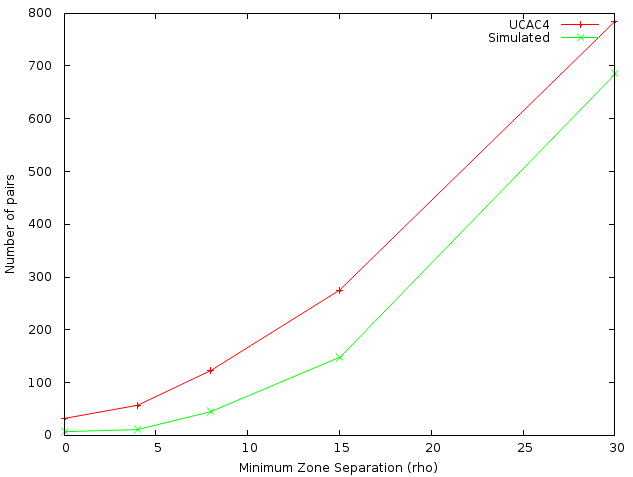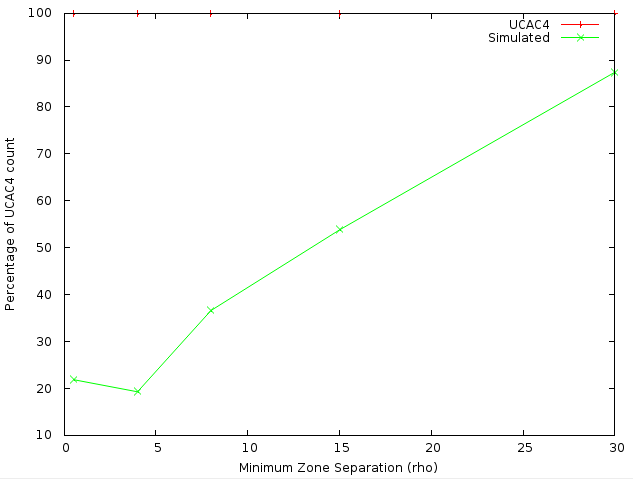
Little Tycho Observatory
703 McNeill Road, Silver Spring, Md 20910
rkk_529@hotmail.com
There are numerous binary pairs that are not in the Washington Double Star Catalog (WDS)1 that appear to be physical binaries. We show in this study that such pairs are often optical using Monte Carlo simulations of the sky.
A casual glance at the photos in the DSS2 with Aladin3 or WikiSky4 will reveal pairs of stars that seem to be isolated from other stars in the field. These wide (> 4") pairs, whose components are within a visual magnitude of each other, are sometimes not in the WDS. If they also have similar blue magnitudes, this would imply that their spectral types are also similar, which further suggests they are at similar distances, and probably orbiting one another.
To test the idea that two stars within 60 arc seconds of one another are physically connected, all stars brighter than 15mv and within 20 degrees of the north galactic pole (NGP) were selected from the UCAC45 CCD astrograph catalog. The NGP was selected as the stellar density there is less than in other regions of the sky, thereby increasing the probability that pairs in that region are physically connected.
To be included in the study, the stars had to be:
There were 129,762 stars found within 20 degrees of the NGP that met these criteria for the study.
A program was used to create an artificial sky, randomly assigning the stars to different positions within 20 degrees of the NGP. The magnitudes and proper motions of the stars themselves were unchanged.
A program to locate binaries was created to search the data, both real and simulated, for binary pairs using the following rules:
The pairs that were found were divided into 5 zones, based on their separations (ρ).
The results from the stars of the UCAC4 yielded:
There were 1271 possible pairs found.
The artificial sky was simulated 100 times, and the results shown are the averages of these runs.
There were 893 possible pairs found.
These results are graphed below. The X axis value of each datum reflects the minimum value of a zone, e.g. 0 = zone 0" - 4".

This can be shown more clearly if the number of simulated pairs for a given bin is shown as a percentage of UCAC4 for that bin. The UCAC4 data are set to 100, in a line across the top of the figure:

Note that for the simulated pairs, the wider the pair zone, the closer its numbers get to those found in the UCAC4 survey. This indicates that many wide pairs, which at first glance appear to be mutually orbiting one another are are actually optical pairs or that their orbit is so large as to be easily disrupted when the pair interacts with the other stars, clusters, and spiral arms of the rest of the galaxy.
For details on the computing required to conduct this study, please see the appendix below.
The author is deeply grateful to Tom Corbin and Bill Hartkopf for their many technical comments and error catches that significantly added to the accuracy of this paper. He also recoginzes the grammatical edits that Kathie Bryant made, which enhanced its readability.
2) The Sloan Digital Sky Survey web site.
5) The Fourth US Naval Observatory CCD Astrographic Catalog (UCAC4). Zacharias, et al, 2012.
-------------------------------------------------------------------------Appendix
The programs used to generate this study are available on SourceForge: Click here to access them.
You'll also need the gcc compiler and perl on your machine, as well as about 100GB of disk space for the data to reproduce this study. Windows users can run them under cygwin.
The UCAC4 catalog is available on line (see its on line site in the above references) in binary format.
The catalog data are placed in a data directory. On the author's system, for example, it is /work/astro/data/.
The UCAC4 data are first parsed with readUcac4.c, and then ucac4TextToNA_Format.pl and splitUCAC4intoDecZoneFiles.pl create the data read by getDataFromCatalogs.c.
The format of the transformed UCAC4 data are then rendered into a "standard" format:
ra|dec|R|G|B|Visual Magnitude|Catalog|Name|pmRa|pmDec|ePmRa|ePmDec 1 2 3 4 5 6 7 8 9 10 11 12
The data itself is split into 180 different files, one for each degree of declination, and placed in directories named naFormatData which are placed in a sub directory, e.g. /work/astro/data/UCAC4/naFormatData.
From these files, the stars within 20° of the NGP are found and placed in their own file.
We are now ready to create a simulation of the NGP stars. SimulateNGP.c does this by assigning a randomly chosen position for each of the stars in NGPstars. The magnitude and proper motion data for the stars are left intact.
Binaries are then found by findBinaries.c
Note. The following command will compile the C programs. Here programName.c is the C source code, and executableName is the executable the compiler creates:
gcc -std=gnu99 -O2 -o executableName -Wunused programName.c -lm
The graphs were made using gnuplot.